Michael Seres, ideaXme human health, medical innovation and technology ambassador, interviews Dr. John B Charles, former Chief Scientist of the Human Research Program at NASA.
Healthcare for Mars
Here is a rare opportunity to learn about the human who for many years was responsible for overseeing NASA astronauts’ health in space, that is healthcare for mankind’s journey to Mars.
Discover the details of Dr. John B Charles‘ work before his recent retirement, as well as what occupies him now, an intriguing art project based on declassified secret research.
Moreover, learn of his human journey, what he has learnt both professionally and personally and the questions that still remain.
Discover how John B Charles has worked to open the gateway for mankind’s journey to Mars.
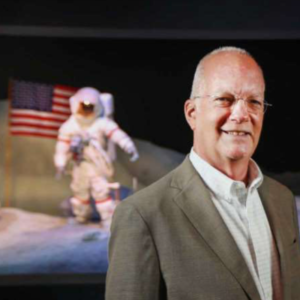
Dr. John B Charles until recently Chief Scientist of the Human Research Program, NASA talks of his 35 year career, what occupies him now, his human story and about the fascinating forensic research project involving a deceased artist and recently declassified NASA research.
He discusses whom would he like to meet and what question he would like to ask that person.
Dr. John B Charles retired in February 2018 after a 35 year career at NASA. He reached the position of Chief Scientist, Human Research Program. There were many career highlights, which are discussed in this interview, including his part in the One-Year Mission in which astronaut Scott Kelly and Russian Cosmonaut Mikhail Kornienko spent a year in 2015 on the International Space Station (ISS) to advance research of medical, psychological, and biomedical challenges of humans on long-duration missions.
Michael Seres, ideaXme human health, medical innovation and technology ambassador interviews Dr John B Charles. Michael is a medical innovation entrepreneur, considered “one of the strongest patient voices on Earth” and a bowel transplant recipient.
ideaXme interview with Dr John B Charles
Michael Seres: [00:00:00] I am Michael Seres, the ideaXme ambassador for human health, medical innovation and technology. Who are you?
The person who was responsible for healthcare so that astronauts could reach Mars
John B Charles: [00:00:00] My name is John B Charles. I’m a retired NASA civil service scientist. I had my dream job. I was able to live my childhood dream, a dream of ending up as the Chief Scientist for NASA’s Human Research Program. I got to be one of the guys who decided what scientific research in the human health life sciences area we performed on the Space Station, on the Space Shuttle in preparation for journeying to Mars.
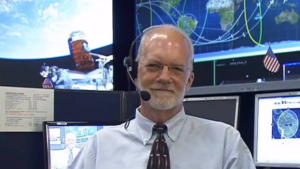
Fulfilling a childhood dream
[00:00:29] So, right away even as I say those words in retrospect it sounds like I am Dr. McCoy. However, it was the culmination of a career of preparation and a career’s worth of activities at NASA. Well worth the effort. Now that I am retired I would not go back. It is time for the next generation to pick up and move forward. I am enjoying watching it from the outside.Michael Seres: [00:00:53] You said that you fulfilled a childhood dream. I am curious. Was the dream about Space, or was the dream about Space science?
John B Charles: [00:01:05] It was always about Space, and that means it was about science because you were either going to be a scientist or an engineer to be involved in the space business, at least in the 60s and 70s and 80s when I was formulating myself. Nowadays, of course, you can be in the space business as an artist or entrepreneur, but that was not an option then. I chose the easy way which was science.
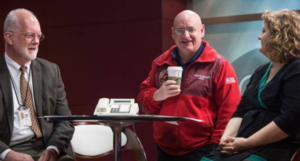
The unglamorous side of healthcare
Michael Seres: [00:01:27] I am a patient who is now involved in healthcare, in literally the most unglamorous end. We work with patients who have ostomies, so we measure what comes out of the body to determine what to put in the body using ostomy bags. As a layman, I have always looked to Space as the great frontier, the future. Do you think we take enough learnings from the areas that you have been working in and bring that into everyday healthcare?
Fascination for the human body
John B Charles: [00:02:02] Let me address the first point you made which is understanding what comes out of the body. It just turns out that as a physiologist, I am fascinated by what comes out of the body. When I give my personal tour of Space Center Houston, which is the official visitors’ centre of NASA’S Johnson Space Center in Houston at which I am now in my retirement the scientist in residence I make sure to point out the toilets to the people I am touring around.
I show them the Shuttle toilet, the Space Station toilet, which is different in important ways from the toilets that we are all familiar with. Everybody seems to resonate with that. It is not just teenage boys who are fascinated by what comes out of the body. It is everyone. We all go to the toilet. So, it is a good way to connect people with what seems typically like an esoteric and perhaps even an unapproachable topic which is spaceflight. So, I am cool about all that squishy stuff. I am also the guy that picks up the dog poop when we go for walks. I am the guy who cleans up the dog barf.
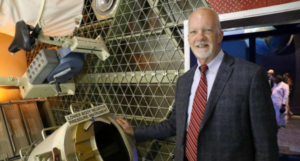
Michael Seres: [00:03:03] We are in the same club where that particular job is concerned! I have grown up with bowel conditions. I have had an intestinal transplant and therefore been attached to bags like ostomies bags, so I have always been fascinated that they have just always been seen as collection vessels when we can learn so much from what comes out the body.
Lessons from delving into biomedical and biological data
Michael Seres: You’ve gone through so much delving into data by biomedical, biological data. Do you look to everyday life for lessons to then translate into the work that you have been doing, or do we tend to follow? Presumably, you are at the cutting edge of a lot of the research that you are doing.
NASA follows clinical medicine on the ground
John B Charles: [00:03:50] That is an interesting topic. Right now, NASA is following clinical medicine on the ground. We have advertised spaceflight as providing new avenues and a new understanding of the human condition that will benefit life on Earth, and I will be blunt and honest with you that we have not reached that yet.
Right now, the knowledge flow is from the clinic on the ground to the astronauts. As an example, we use Fosamax on astronauts to protect them from the loss of calcium, bone mass. This drug was developed for post menopausal women. But we’ve also shared what we’ve learnt about bone mass. Loss of bone mass turns out to be an area where we do provide some benefit to the ground. We learnt that by adding a significant amount of resistive exercise to exercise programs not just treadmill, not just bicycle exercise but actual zero gravity weightlifting to astronauts’ workouts helps to reduce bone loss.
NASA’s healthcare for Mars which benefits ground populations
We learnt that zero gravity weightlifting seems to help protect astronauts’ bones. It then resulted in a prescription for osteoporotic post-menopausal females to add more weightlifting more resistive exercise to their exercise protocols which I believe has shown benefit on the ground populations. So, this is an example where both sides benefited.
[00:05:17] But Michael, the story there is equally interesting for me. I am not an apologist for the fact that we have not cured cancer with space flight. What I have been interested in seeing over my career is the fact that every time we get an answer from spaceflight in my experience, it has been something we should have already known. Every time I have tested a hypothesis in my domain which is cardiovascular, and the answer comes back; our response is always a face slap, “of course, why didn’t we know that already?”Finding commonality between ground and space healthcare
[00:05:44] To rationalise what I have said: “until you know the answer, there is an infinite number of possible answers”. Once Mother Nature tells you which one of those infinite possible answers is correct, until you get that confirmation you do not know that because it could be anything. However, in retrospect it was obvious. We seem to have a good grasp of what makes people tick on the ground and in space and find an awful lot of commonality between ground and space.Being smart about healthcare in space
My friends who continue to work in the space life sciences business are not unburdened as I am by being retired and will say that there are many differences between spaceflight and life on Earth and I will not argue with them. In my way of condensing many thoughts to a single nugget or two; I will say that there is a lot of commonality and a lot of lessons that we learn that tell us that we are already smart about people in space.
Michael Seres: [00:07:07] Do you arrive at those conclusions because you’re more focused in the research that you (space life sciences researchers) do and we (clinical researchers) are less so here? Or, is it just as you said, you don’t know until you know?
The difference between people who do Spaceflight life sciences research and people who do ground-based medical research
John B Charles: [00:07:21] I think it’s the latter and the reason I say that is because there is not a fundamental difference in the kind of people that do space flight life sciences research and the people who do ground-based medical research. We go to the same conferences; we read the same journals, we talk to each other.
[00:07:33] We invite them to come and talk to us. They invite us to come and talk to them. So, there is a healthy intermixing between the two groups. We’re a much smaller population than the clinical research population. If there seems not to be a healthy intermixing, then we bring in folks that have a different perspective to give us a fresh view. We turn over our research management and our research staff frequently. [00:08:07] We give ourselves extra points for bringing in people who are new to the space business. We make sure we have fresh blood.Monitoring of astronauts’ health and the lessons learnt
Michael Seres: [00:08:12] One of the other areas I want to ask you about is data. I am guessing that you’re transmitting that research data continuously from space, analysing it continuously. We talk today on the ground, so to speak, about real-time monitoring in healthcare; the ability to access and make decisions about data in real time. That’s going to change the way patients like me can manage ourselves. Are there lessons learnt there or is that another area where we (Earth and space health researchers) mirror each other?
John B Charles: [00:08:50] This is one of the areas where I get to disappoint folks interested in spaceflight. We do very little monitoring of astronauts in spaceflight.
How much monitoring of astronauts should we do?
[00:09:00] Every poop and pee are not monitored. Frankly, we tried to build a urinal that would analyse the urine for every void, and it didn’t work. It caused problems, so it was thrown away. Astronauts are only monitored when they volunteer for specific investigations. There is no ECG running continuously. The thinking is, “they are on the Space Station currently for six months at a time. That’s their home. That’s their place of work. The place they go to relax. They’re there 24/7 52 or at least 26 weeks at a time. Nobody should be expected to be the guinea pig for that long. I disagree, but their logic has prevailed. They have won that argument. I concede that it is a reasonable point.I monitor myself with a Fitbit
[00:09:54] Not everybody is like me. Not everyone wouldn’t mind being monitored. I am wearing a Fitbit watch, so I am monitoring myself continuously. And they have the equivalent of that, but they still insist on wearing it only intermittently. They want to have time when they are not a guinea pig. I get that but like I say, when we do monitor them intermittently we try to make it continuous.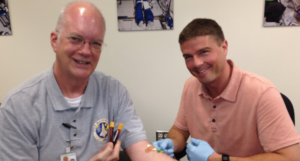
Michael Seres: [00:10:17] It does. I just showed my naivety in the question I asked you. I assumed that you’d be tracking. Not everybody down here wants to be monitored 24/7.
John B Charles: [00:10:37] To pursue that a little more. Some monitoring does take place continuously. For example, we have engineers who monitor the environment.
Monitoring CO2 on the Space Station
[00:10:43] We’re especially looking at the carbon dioxide levels. It turns out that it is a lot harder to scrub out carbon dioxide from the atmosphere. You burn out carbon dioxide scrubbers, they have to replace them and have to fly new ones. We tolerate a higher level of CO2 on the Space Station than you, and I experience here on the ground.John B Charles: [00:11:12] The high levels of CO2 on the Space Station are right up the bleeding edge between unobtrusive and what starts to cause headaches and if it increases a bit more may start causing cognitive errors. So, there is a constant dynamic between the engineers who don’t want to have to find money in their budget for a new CO2 scrubber because “this one is maintaining CO2 levels that the Navy says is perfectly acceptable in nuclear submarines when they are 6 months under the ice” and the astronauts who insist that they are so delicately tuned to it that they can tell when CO2 increases even a little bit and they start getting headaches and start feeling “space stupid” as they call it.
[00:11:51] This is one example where we are monitoring continuously. Another is the gyros that monitor the vibrations, the motions in the space station. We know when people are moving but can’t tell you which of the six people onboard is doing so.The highlight of John B Charles’ career
Michael Seres: [00:12:28] You’ve had such a distinguished career. I am probably asking you a hard question. Is there a particular moment, research project or experiment that you would say, “that’s been the highlight of my journey?”
John B Charles: [00:12:50] Forgive me for boasting, but there have been several highlights because I was so lucky to have my dream career. The first highlight was inheriting my NASA mentor’s cardiovascular study investigation.
Chief Scientist on the last mission of the Space Shuttle Columbia
[00:13:10] I worked on that investigation. It made my scientific career. It led me on a path to be the Chief Scientist, not the cardiovascular scientist but the guy that oversaw all of the scientists on several of the American flights to the Russian Space Station Mir. It positioned me to be the guy that they called to be the Chief Scientist for John Glenn’s mission. So, because of a few lucky breaks along the way I was situated to be on a first name basis with my childhood idol. It still gives me chills today to think about. That was 20 plus years ago. It positioned me to be the Chief Scientist on the last mission of the Space Shuttle Columbia.So, I was the guy that oversaw the science on Columbia and then when we wrapped up for reentry. I was home on the morning when Columbia disintegrated above East Texas. I was indirectly involved in some of the recovery activity.
Chief Scientist for Human Research Program
[00:14:05] So there was a low point that followed quickly from the earlier high point. But then that was followed by what was probably the high point of my career which was being the Chief Scientist for the Human Research Program. I was the guy who had the opportunity to put together the research for a one-year mission of Scott Kelly and Mikhail Kornienko on the International Space Station which seems to be the most recent major accomplishment on my resume. Now I am having a lot of fun being the Scientist in Residence at the Space Center Houston Visitors Center. I now have the opportunity to do all the fun stuff and none of the tedious bureaucratic stuff.Michael Seres: [00:14:42] Are you asked a lot of similar questions?
John B Charles: [00:14:46] Constantly, because this subject is new to people. They haven’t been in a position to think about it every day for thirty plus years. It’s a new question for them. I appreciate the chance to educate them.
Michael Seres: [00:15:02] How did the Human Research Program come about?
John B Charles: [00:15:10] The Human Research Program was initially called Bio-astronautics, and it was a NASA headquarters in Washington D.C. It was the organisation that primarily doled out the funding to all the ten field centres that do space life sciences research. Primarily to the Johnson Space Center in Houston, the Kennedy Space Centre in Florida and the Ames Research Center in California. Those were the three prime locations for space life sciences research.
Locating life sciences management at the Johnson Space Center
[00:15:36] About the turn of the century a new administrator came into NASA headquarters. The administrator said, “there are too many people in the halls at headquarters. I’m going to send as many functions as I can to other field centres. Johnson Space Center was already extremely well populated with life sciences so he said. “Let’s put life sciences management at the Johnson Space Center”, and that’s where I was. I was senior enough and had the experience to end up being first Deputy Chief Scientist and eventually the Chief Scientist. [00:16:13] So, NASA folks who are upwardly mobile usually do a tour of duty at headquarters in Washington wherever they come from. I did my tour of duty of Washington at home. They came to me instead of me going to Washington.Michael Seres: [00:16:25] You would do it all over again if you could rewind the clock?
I reached the point where I could ask stupid questions
John B Charles: [00:16:31] I would enjoy it and tell myself not “this too shall pass”, but I would tell myself to “enjoy the ride more”. I eventually got to the point where I could ask the stupid questions and not grasp things without having to worry about what my boss thought of me because I was up close to the boss already.
[00:16:46] I wish I could have got to that point and have had a level of self-confidence early. So, I tried to enable the folks that were still climbing the ladder to ask the dumb questions and not be afraid of showing their ignorance in public. It is the brave person who asks the question. Everybody else wants to ask the question, but they are afraid to do so. There’s a sense of relief in the room when someone else asks the question, and we can move on.A brave and brilliant manager
Michael Seres: [00:17:13] I think it takes a brave manager to create an environment to allow you to ask the questions, so you are a brilliant manager.
[00:17:22] If you were starting over again are there any projects today that you would love to work on?John B Charles: [00:17:33] The nice thing about being the manager, the Chief Scientist is that they are all your projects. I can see bits of my inspiration in all of them and the other thing about being a manager is that you don’t get to take credit for that.
[00:17:47] You put the ideas out there, and the good ones take root and become somebody else’s brilliant idea. You may know that was my idea, but you can never say anything about that publicly because the other guy has the publications and the research that ‘prove’ that it was his idea. But it’s like scattering seeds and seeing which ones grow.Cardiovascular healthcare
[00:18:06] So I always loved the cardiovascular system partly because it was simple enough so that I could understand it. And I loved the experiments that I was doing especially the one that I inherited from a mentor. It’s interesting because that experiment went fallow for a couple of decades and then came back to the space station. Somebody else is getting a chance to build his career on that research where I would love to be doing it, but I don’t call up and ask why because I want to interfere.Mentoring
Michael Seres: [00:18:35] Do you mentor anybody now?
John B Charles: [00:18:46] I still have an office at NASA. I am what they call “Emeritus”. That means that I work one day a week with no pay. I am available any time people want to talk to me. I try to be there one day a week. Occasionally someone comes in and shoots the breeze, and it turns out they were being mentored, and they didn’t realise it. So, I am available and anxious to apply my wisdom while it is still current and before it becomes out of date.
Michael Seres: [00:19:19] It sounds to me that as somebody has picked up your historical research and is continuing with it, that your work will never be out of date.
John B Charles: [00:19:28] That’s reassuring for me. I recognize many of the words. Being the old guy, I have a broader perspective than many of the youngsters do. I can say, “have you thought about this? Somebody tried that and here’s what he or she found. So, go make some new mistakes. Don’t just make the old ones all over again!”
Michael Seres: [00:20:02] Is there a sense when you were there that things move faster in space health science? I mean you’re dictated to by missions with deadlines. Is there a different sense of speed doing your academic research compared to maybe research undertaken in a hospital environment? Is there a different sense of urgency or expectation of the outcome? Or is it very similar?
John B Charles: [00:20:28] I’ve never worked in a clinical environment, so all I know is what I have learnt from watching the tv series, House.
Solving health problems associated with Spaceflight
John B Charles: [00:20:40] We are supposed to be solving specific problems of spaceflight and not discovering new knowledge. Our goal in the Human Research Program when I was the Chief Scientist was to understand the set of risks that we’ve identified for astronauts going to Mars. If we happen to cure cancer along the way well, it couldn’t be avoided. We didn’t mean to, and we’re sorry.
[00:21:14] Our job is to protect astronauts. It turns out that because astronauts are people and people on the ground are people there are a lot of commonalities between what happens.Monitoring astronauts’ health in Space
[00:21:25] Astronauts are incredibly healthy people in an unnatural and sick environment so they have to cope with weightlessness, vacuum, radiation, altered day-night cycles, high stress, isolation and things like that. Patients (on Earth) are sick people in a normal environment which is normal gravity, regular day-night cycles, normal radiation environments, normal temperatures but because we’re all the same protoplasm inside there are commonalities.Sharing Space health knowledge and learning from clinical studies focusing on patients on Earth
Michael Seres: [00:22:01] Presumably, as well as seeing commonalities you must see differences in recovery periods? Are there lessons learned to be learnt there? That fascinates me! How do we learn from one another? I assumed that we ‘on the ground’ would learn far more from Space science.
John B Charles: [00:22:23] You would assume that because that’s what we tell you! This is just between you and me Michael and nobody else can ever hear this. Currently, we learn more from clinical studies which focus on patients here on Earth than the other way around. This knowledge is used to protect astronauts.
Commercial Space stations
[00:22:37] We are an operationally orientated goal-driven organization without the luxury of being able to do curiosity-driven science. However, when the commercial sector fully moves into Space and starts building commercial space stations, prices to journey to Space will decrease and the Professor and his grad students can go into orbit and do research. Then we will see more novel knowledge inevitably from spaceflight for the benefit of all life. We have just not had that luxury because our goals have been very constrained.Commercial exploits into Space
Michael Seres: [00:23:17] So do you see the commercial exploits into Space as a good thing?
John B Charles: [00:23:28] Definitely good but we need to reduce the price of tickets to travel to Space. Right now, if you’re going to buy a ticket from the Russians to fly to the International Space Station, it’s 60 million dollars per warm seat!
When will we see grad students in Space?
[00:23:49] The commercial sector, Space X‘s Crew Dragon and Boeing‘s Starliner haven’t had to price the product themselves. They look at what the Russians are charging and charge 10 per cent less. So, they’re going to be charging 50 million dollars per seat. [00:24:10] As long as that’s the case you’re not going to get that Professor and his grad students doing research in space. The price must come down to five thousand dollars per seat or near to that figure. There needs to be an awful lot more spaceships and a lot more rockets offering destinations in orbit. [00:24:27] Universities with their endowments should start funding their in-orbit laboratories for research instead of funding their football teams. I am hopeful that will happen. It can only happen through the commercial sector. We are still a long way from that happening.Michael Seres: [00:24:44] Can you see it happening in our lifetime?
John B Charles: [00:24:47] Well maybe in your lifetime. You look young. So, I’m guessing that you have a few more decades than me. I hope that one of my last conscious thoughts, before I tip over, will be, “good it is finally starting to happen”.
Michael Seres: [00:24:57] Whom would you like to meet? I wondered before this interview whether you might like to see John Glenn again? Or, is there someone else whom you’d still like to meet and if so, what question would you like to ask them?
John B Charles: [00:25:09] I have several answers. I did talk with John Glenn. If you bear with me Michael, I’ll walk you through my thought process. I was thinking of people who are no longer alive.
Secret military research project
[00:25:44] There are two people who are no longer with us that I would like to be able to talk with. One is an artist who generated a set of about three dozen paintings depicting a secret military space project that has since been declassified. I acquired these paintings by accident. That program was cancelled. The paintings were dumped in a dumpster, and someone in the organisation rescued them. He put them in his garage for thirty years. He died and his family had a garage sale, and someone picked them up. [00:26:13] They wrote to a friend of mine who put the word out to a bunch of us. I said “Yes, I’d like those and eventually I got a chance to acquire them. I am making public presentations about this top-secret military space project.My forensic research project focusing on artist Neil Jacobe
[00:26:31] The name of the artist is Neil Jacobe. I say this just in case his family is listening. He passed away almost exactly at the time I bought those paintings, so I never had the opportunity of asking him what he thought when he did this work.A message for Neil Jacobe’s family
[00:27:07] Over the last five years or so I have been doing forensics on Jacobe and the project. I’d still like to be in touch with his family and ask them, “did your dad ever talk about this project?” I spoke with a corporate artist who worked with him, overlapped with him. This gave me a little insight into his character and work.What are your disappointments and accomplishments? What are you proud of?
John B Charles: [00:27:42] The other person I’d like to talk to, which is a surprise to me and maybe to you also is my father. My dad passed away 15 years ago. Although we had a good relationship we never talked about his youth, his childhood and how he got to be where he was. I would like to ask him “What are your disappointments? What are your accomplishments? What are you proud of?”.
Final moments with my father
[00:27:50] It became clear to me, this is for listeners as well. It became clear to me when he died. My mom called me to come to his bedside. He had an aneurysm. I got there just in time for them to ask us if we wanted them to do CPR. Everything else had failed. They did it, and then it did not work. So, there he was on the table. They cleared the room. When someone passes away in the ER, you are given your final moments with the deceased person.Teetering on the edge of infinity
[00:29:32] I had the very vivid sense of teetering on the abyss of infinity because here was this man who still had things that I wanted to talk to him about. His face was as clear to me as your face is now. There was no way that I could reach him. He was no longer there. Even though I could touch him. I could stroke his head. I could look into his eyes. He was gone. After fifteen years of hindsight, I would like to go back.I talk to my father in my dreams
Periodically, I talk to him in my dreams. I try to find out things. It is nothing that I don’t already know. I am not trying to prey on your sympathy or be morbid. The greater picture is that I have a sense of infinity now, know viscerally what it means. I don’t think a lot of people do. They think of it just as a number. This has framed my thinking. I try to be more patient, more expressive, more effusive than before so that nobody feels that he or she has missed that opportunity with me. I probably tell them more than they want to hear just so they don’t miss the opportunity.
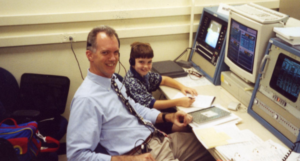
Michael Seres: [00:29:50] I had the privilege of having a grandma who reached a hundred-years-old. She passed away two months ago. Listening to you describe your experience with your dad, I think that experience resonates with everybody, the realisation that there are still so many things you want to go back and ask when someone close to you dies.
John B Charles: [00:30:07] You never finish.
Michael Seres: [00:30:08] You never finish. So, I’m going to finish with the question about how you started.
What was it about Space that fascinated you?
Michael Seres: [00:30:12] As that little kid growing up with your dad, what was it about Space that fascinated you? What drove you to want to do this?
John B Charles: [00:30:23] I was a child of the early 60s. I was born in 1955. The Space Age began in 1957. America’s first satellite was in 1958. Astronauts were all the rage in the early 60s. My mom said that she used to get fashion tips from pictures of astronauts’ wives in Life Magazine.
Fire in the belly
[00:30:41] So, it was that pervasive in our culture. There was something about it. You cannot describe what it is precisely. I call it fire in the belly. There was something about flying into Space especially in my case being weightless. I am fascinated by gravity, by its essence and how weightlessness affects our bodies in so many ways that are obvious and I hope in ways that are not obvious. We just haven’t found yet.Getting a chance to see a God’s eye view of the Universe
[00:31:03] There was something about being on top of a big rocket. Being the point man for a national effort. Being the guy that it all depended on and getting a chance to see this God’s eye view of the Universe and being beyond gravity, being essentially removed from it that appealed to me at the age of seven and has never left me. [00:31:26] But maybe before that, I wanted to be a cowboy, an artist and a clown. The usual things a kid wants to do, especially a kid growing up in Central Texas. Oh and a soldier before Vietnam became extremely visible.Tailoring my education to get into the Space business
[00:31:44] I always wanted to be in the Space business. My education was tailored to get me as close to where I could be and I had several lucky breaks.I know that I am incredibly fortunate. However, luck favors the prepared! I was prepared, and I got lucky. Having said all that, that’s how I got where I am. If I could tell myself as a younger me, I would probably say, “buck up, you think that it looks bleak now. You think that you’ll never get out of college. You’ll never get out of school. Yes, your dissertation research crapped out on you, but you are going to recover, and you will be better for it”.
Dark days at grad school
[00:32:30] There were some dark days in grad school. Not only did I think I will never be in the Space business and I will never get out of grad school, I thought that this is just going to go on forever. This is torture, and it turned out to be some of the best days of my life. That’s an indication of what I was thinking then and how it has benefited me since then.A nice conversation. I’d like to say “hi”
Michael Seres: [00:32:50] I cannot tell you enough what an honor it has been to talk to you, John. I was worried about doing this interview because of all the things that you’ve achieved and everything that you’ve done. You have been the kindest person to interview. This just feels like a nice conversation. At some point in the future, I’d like to walk by when you’re in your role as the Scientist In Residence and say: “hi ” and remind you that I”m the guy who talked with you on a Skype call. I’m grateful for your time today, I really am. It’s been an absolute pleasure talking to you.
A promise to stay in touch
John B Charles: [00:33:40] Michael, I have enjoyed talking with you as well. You have put me at my ease. We’ve had a lovely chat. I do hope that we have the opportunity of crossing paths. I’d like to sit, have a drink and continue our conversation. I am hoping that you will send me the link to this interview, so I can share it with my friends.
Michael Seres: [00:33:47] Of course. We’ll stay in touch if nothing else as friends.
John B Charles: [00:33:53] Please do Michael. I would love that. I think that we have more conversations ahead of us.
Photographic Credit: NASA. All photographs were supplied by Dr John B Charles.
Edited by ideaXme Ltd. Copyright ideaXme Ltd
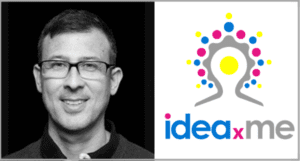
Credits: Michael Seres interview video, text, and audio
For more ideaXme interviews in the lead up to our 2016 launch:
Follow ideaXme on Twitter: @ideaxm
On Instagram: @ideaxme
On YouTube: ideaxme
Find ideaXme across the internet including on iTunes, SoundCloud, Radio Public, TuneIn Radio, I Heart Radio, Google Podcasts, Spotify and more.
ideaXme is a global podcast, creator series and mentor programme. Our mission: Move the human story forward!™ ideaXme Ltd.
The transcription of this interview has been edited to improve fluency.
Follow and find out more:
@patientcoaches Instagram
@mjseres Twitter and Twitter John B Charles @csm014
We feature the humans behind the big ideas that shape our world. Our mission is to support and inspire both existing and future creators. Furthermore, to entertain all those who love big ideas and great stories in the process.
Read, listen to, or watch our interviews.
© copyright ideaXme Ltd.
Move the human story forward!™ ideaXme Ltd.


Pingback: Human Head Transplant
Pingback: Science Through the Poetic Lens
Pingback: Fighting Environmental Injustice
Pingback: Engineering, Empathy & Innovation: PakVitae Solving Water Problems for the World